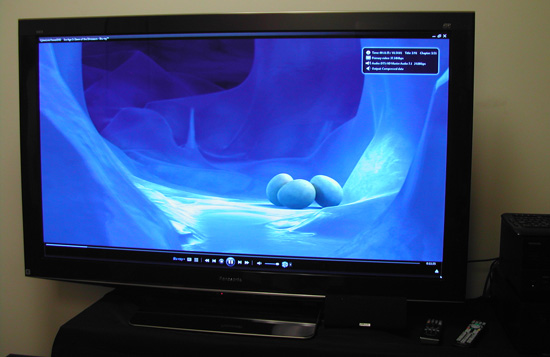NVIDIA's GeForce GT 430: The Next HTPC King?
by Ryan Smith & Ganesh T S on October 11, 2010 9:00 AM ESTThe GT 430 is not as bad a HTPC card as the HQV benchmarks might lead one to believe. It is the first sub-$100 component to enable HDMI 1.4a and playback of all 3D formats. In addition, users can also expect 3DTV Play to enable them to play 3D games on a TV when NVIDIA releases that software package in the future. However, the suitability of the GT 430 for gaming purposes is covered elsewhere in this piece. From a HTPC perspective, it enables cutting-edge technology without any sort of price premium.
For a consumer interested in the 3D ecosystem, the GT 430 is definitely a better option than the similarly priced HD 5570. The GT 430 also brings the latest and greatest of VP4 to the table. This includes full MVC decode acceleration enabling hassle free playback of 3D Blu-Rays. The GPU also scored a perfect 100% in our media streamer test suite, and had no issues with bitstreaming HD audio of any kind. Flash acceleration works very well and sites such as YouTube and Hulu benefit handsomely. Silverlight also utilizes GPU acceleration. Netflix is able to take advantage of the same.

NVIDIA's 3D TV Demo Room
3D works as advertised, and I had the opportunity to simultaneously experience 3D and HD audio bitstreaming at the nVidia Santa Clara HQ demo room. More than the 3D videos, I was impressed by the stereoscopic photographs slideshow on the 3D TV enabled by the GT 430. They also had on display some 3D cameras and camcorders. With a 5 year history of developing for the 3D ecosystem, it finally looks like nVidia's efforts are beginning to bear fruit. Now, if only we could find some way to get rid of those glasses....










120 Comments
View All Comments
duploxxx - Friday, October 15, 2010 - link
makes you wonder how good your IT qualities are.... had tons of ati and nvidia cards, never had issues with ati or nvidia. Sure both of them have had a few glitches but that is more due to MS and the drivers.btw it's often due to crappy OEM implementation of the vendor driver, ever thought of that????
dnd728 - Friday, October 15, 2010 - link
Another Einstein...Fallen Kell - Tuesday, October 12, 2010 - link
I bought a passive AMD 5750 which I use in my HTPC, mainly to gain Blu-Ray audio bitstreaming. I have to say, AMD still has a lot of work they need to do in terms of their drivers. As much as I love the capabilities of this card, I spent 5 days getting it to work properly and output the bitstreamed audio. I think that is probably a large reason why their market share hasn't grown. It should have just worked after I installed the latest drivers. But no, I had to download a specific version (not the latest), had to also download audio drivers from ANOTHER company entirely (not AMD), get a specific version of those drivers (not the latest), install them in the proper order (i.e. install the third party drivers after I installed AMD's drivers).... It was hoop after hoop after hoop.... A normal consumer would have simply taken the card back as "broken".khimera2000 - Thursday, October 14, 2010 - link
I had to change the default audio after the ATI drivers installed... it took me two minuts to get it working ;Dtherealnickdanger - Monday, October 11, 2010 - link
If image quality is so important, you wouldn't watch anything but 1080p24 Blu-Ray in the first place! :)But seriously, in the days of DVD, HQV tests were of higher importance because DVD was 480i, when the movies and television shows were typically sourced on film @ 24 fps. With Blu-Ray, you get to watch TV and film in the native cadence with no deinterlacing, and you certainly don't want resoution scaling or conversion of any kind. Any attempt to artificially smooth or sharpen the image would adversely affect image quality.
The most important feature to home theater enthusiasts is the purest representation of the original source, without enchancements or filters.
ganeshts - Monday, October 11, 2010 - link
I am sure there are plenty of HTPC users who shoot using camcorders like the Flip or the Playsport. Not all of those videos are in 60fps. 30 fps videos need to be 2:2 pulled-down. Cadence detection helps a lot here.In addition, Blu-Ray also allows 1080i videos. Of course, if you have a video processor, source direct is best. However, a good HTPC is supposed to make a video processor redundant.
We have mentioned in the review that power users can always work around the unimplemented features by doing a 'source direct' playback.
Stonedofmoo - Monday, October 11, 2010 - link
For me the only reason I was holding out for this card was to see how effective it would be as a dedicated PhysX card to use in conjunction with my GTX460 1Gb.The GTS450 seems rather overkill for just that task so I was hoping the GT430 would be the ideal cheap option..
Ryan Smith - Monday, October 11, 2010 - link
To be honest it's not something I had a chance to test. I've only had the card since Friday afternoon, so there wasn't much room for extras. I'll see if I can squeeze it in today.Stonedofmoo - Monday, October 11, 2010 - link
No worries, it would be interesting to see if it's any use for a dedicated PhysX card.Thanks for the review :-)
Snoopy_69__ - Monday, October 11, 2010 - link
Unless someone makes a fanless GT430